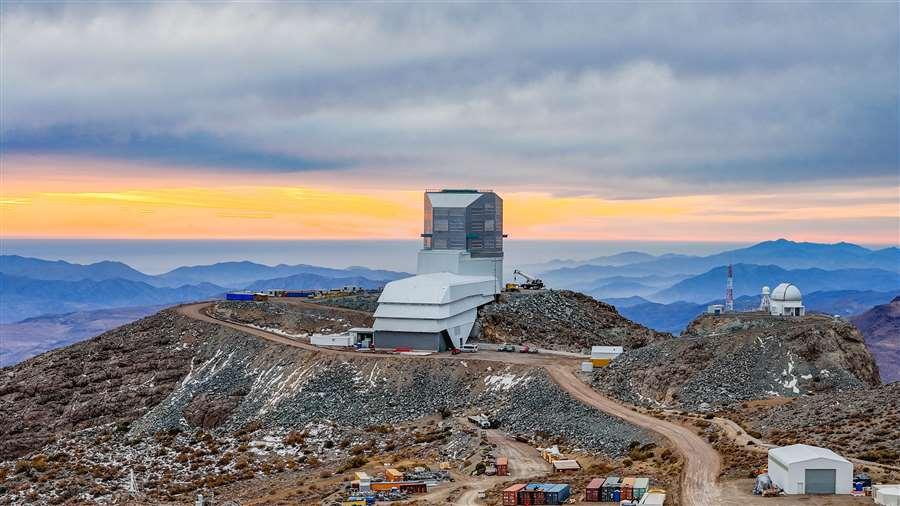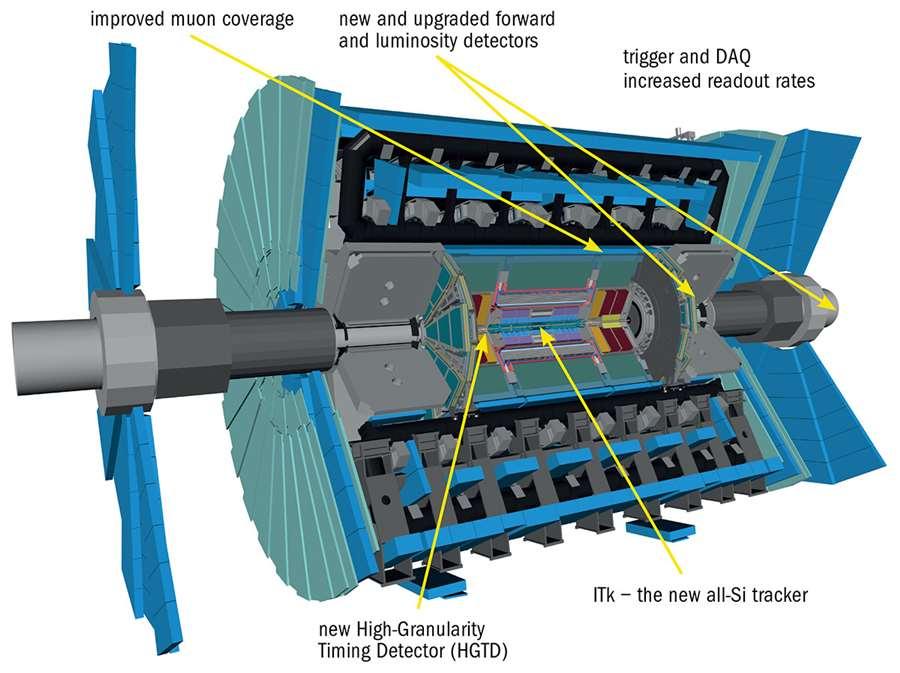R.E.News future Technology-5 major global science facility builds running behind schedule
 19/06/24-FR-English-NL-footer
19/06/24-FR-English-NL-footer
La construction de cinq grandes installations scientifiques mondiales prend du retard

 The Vera C. Rubin Observatory in Chile currently under construction. (Image: Rubin Observatory)-Render schematic of the major upgrades to the ATLAS detector. (Image: ATLAS Collaboration/CERN)
The Vera C. Rubin Observatory in Chile currently under construction. (Image: Rubin Observatory)-Render schematic of the major upgrades to the ATLAS detector. (Image: ATLAS Collaboration/CERN)
La National Science Foundation (NSF) des États-Unis – une agence indépendante du gouvernement américain qui soutient les programmes de recherche et d'enseignement dans les domaines des sciences et de l'ingénierie – a rapporté au Government Accountability Office (GAO) des États-Unis que cinq grands projets mondiaux de construction d'installations scientifiques sont susceptibles de se réaliser. dépasser le calendrier.
La NSF a déclaré que ses données et ses recherches montraient la construction de l'observatoire Vera C. Rubin au Chili, le projet de navires de recherche de classe régionale (RCRV) aux États-Unis, le projet de modernisation des infrastructures antarctiques pour la science (AIMS) à la station McMurdo et les deux grands collisionneurs Hardon. (LHC) Les projets d’amélioration à haute luminosité – situés près de Genève, à la frontière franco-suisse – risquent de subir des « calendriers accrus ».
Qu’est-ce qui cause les retards dans les projets NSF ?
Les problèmes qui entravent les calendriers varient selon les projets, qui sont dispersés à travers la planète, mais présentent certains problèmes qui se chevauchent.
"Plus précisément, le RCRV et l'AIMS ont signalé des pénuries de personnel, chacune avec des causes uniques, qui entraînent des retards de construction continus", a déclaré la NSF. « La pénurie de main-d’œuvre qualifiée constitue un problème pour l’ensemble de l’industrie de la construction navale, particulièrement en Louisiane, où se trouve le chantier naval RCRV. »
Le rapport note également que le chantier naval n'a pas respecté la date de livraison prévue (22 septembre 2023) pour le premier des deux navires qui seront construits dans le cadre du projet.
"Le bénéficiaire retient les sanctions financières conformément au contrat du chantier naval", a ajouté NSF.
L’emplacement éloigné d’AIMS sur le continent le moins peuplé du monde, associé à un marché de compétences restreint dans l’industrie, a conduit à des projets allongés.
La NSF a ajouté que la construction d'un centre d'équipement et d'opérations pour véhicules et d'un centre d'hébergement à la station McMurdo serait probablement repoussée d'un an "en raison d'erreurs de construction et de la disponibilité des matériaux".
"La moindre disponibilité de main-d'œuvre domestique a accru le recours à des travailleurs non américains, et le processus d'obtention de vérifications des antécédents de ces travailleurs prend plus de temps que la période prévue de quatre semaines", a ajouté NSF.
À l’observatoire Rubin, une fuite de vide a provoqué un « retard de plusieurs mois » dans l’expédition d’une caméra, tandis qu’un dysfonctionnement de la grue à dôme a également entraîné des revers.
Les projets NSF dépassent-ils le budget ?
Tous les projets majeurs, sauf un, respectent le rythme ou sont en dessous du budget prévu à ce stade.
La NSF a demandé un financement supplémentaire selon les besoins, le plus pour l'Observatoire Rubin. L'agence a déclaré que le coût attendu de 571 millions de dollars représente près de 100 millions de dollars de plus que l'autorisation initiale et plus de 81 millions de dollars de plus que la projection ajustée pour 2024. Il est prévu qu'il accuse un retard de 31 mois, avec une date d'achèvement désormais prévue pour 2025.
Le projet RSRV a 30 mois de retard et un dépassement budgétaire de 35 millions de dollars, avec une valeur totale désormais de 400 millions de dollars. L'achèvement est prévu en 2027.
Les deux détecteurs construits dans le cadre des projets de mise à niveau du LHC représentent un dépassement budgétaire de 17,8 milliards de dollars, la construction de l'appareil toroïdal étant en retard de 26 mois et la construction du dispositif compact à solénoïde à muons retardée de 22 mois. Les deux unités devraient désormais être construites d'ici la mi-2028 et coûter .
Le seul projet à avoir atteint ou inférieur au budget autorisé et en deçà des délais était AIMS, dont le coût est désormais estimé à 135 millions de dollars de moins et qui se terminera 15 mois plus tôt que prévu en 2027.
Cependant, la NSF réévaluera les projets le mois prochain, et d'autres retards pourraient être annoncés à l'AIMS en raison des restrictions d'accès à la main-d'œuvre et des retards dans les unités d'hébergement et de stockage.
À propos de l'Observatoire Vera C. Rubin
L’Observatoire NSF Rubin est une installation prévue pour un télescope optique à grand champ de 8,4 m, qui photographiera le ciel du sud tous les trois jours pendant une décennie avec le « plus grand » appareil photo numérique du monde (trois milliards de pixels).
À propos des projets de navires de recherche de classe régionale
Le projet RCRV construit trois navires que les scientifiques utiliseront pour mener des recherches sur les côtes américaines
À propos du projet de modernisation des infrastructures antarctiques pour la science
Le projet AIMS vise à moderniser la station McMurdo de l’Antarctique, y compris des installations de stockage et d’hébergement modernisées.
À propos des projets de mise à niveau à haute luminosité du grand collisionneur de hardons
Le projet installe deux détecteurs généraux – un appareil toroïdal LHC (ATLAS) et un solénoïde compact à muons (CMS) – pour l'Organisation européenne pour la recherche nucléaire. Ils étudieront un large éventail de phénomènes physiques, notamment les particules qui pourraient constituer la matière noire.
NJC.© Info NSF
--------------------------------------------------------------------------------------------------------------------
 19/06/24-English
19/06/24-English
5 major global science facility builds running behind schedule

 The Vera C. Rubin Observatory in Chile currently under construction. (Image: Rubin Observatory)-Render schematic of the major upgrades to the ATLAS detector. (Image: ATLAS Collaboration/CERN)
The Vera C. Rubin Observatory in Chile currently under construction. (Image: Rubin Observatory)-Render schematic of the major upgrades to the ATLAS detector. (Image: ATLAS Collaboration/CERN)
The US National Science Foundation (NSF) – an independent agency of the US government that support research and education programmes in the science and engineering fields – reported to the US Government Accountability Office (GAO) that five major global science facility construction projects are likely to go over-schedule.
NSF said its data and research showed the construction of Vera C. Rubin Observatory in Chile, the Regional Class Research Vessels (RCRV) project in the US, the Antarctic Infrastructure Modernization for Science (AIMS) project at McMurdo Station, and both Large Hardon Collider (LHC) High Luminosity Upgrade projects – located near Geneva on the French/Swiss border – are likely to endure “increased schedules”.
What’s causing delays to NSF projects?
The issues hampering the schedules vary by project, which are scattered across the planet, but have some overlapping issues.
“Specifically, both RCRV and AIMS have reported staffing shortages, each with unique causes, that are resulting in ongoing construction delays,” said NSF. “A shortage of skilled labour is an issue for the entire shipbuilding industry, particularly in Louisiana, home of the RCRV shipyard.”
The report also noted that the shipyard missed the scheduled delivery date (22 September, 2023) for the first of two vessels to be built as part of the project.
“The awardee is withholding financial penalties in accordance with the shipyard contract,” added NSF.
AIMS’ remote location on the world’s least-populated continent, coupled with a tight skills market in the industry, led to elongated plans.
NSF added that construction of a vehicle equipment and operation centre and a lodging facility at McMurdo Station are likely to be pushed back at last one year “due to construction errors and availability of materials.”
“The lower availability of domestic labour has increased reliance on non-American workers, and the process for obtaining background checks for these workers is taking longer than the expected four-week period,” added NSF.
At Rubin Observatory, a vacuum leak caused a ‘multi-month delay’ in the shipment of a camera, while a malfunctioning dome crane also led to setbacks.
Are NSF projects overbudget?
All but one of the five major projects is on-pace or underneath its expected budget at this junction.
NSF has requested additional funding as needed, the most for the Rubin Observatory. The agency said the expected US$571 million cost is nearly $100 million over the initial authorisation and more than $81 million more than the adjusted 2024 projection. It is forecasted to be 31 months behind, with a completion date now scheduled for 2025.
The RSRV project is 30 months behind and $35 million overbudget, with a total value now at $400 million. Completion is expected in 2027.
The pair of detector builds in the LHC upgrade projects are $17.8 billion overbudget, with the toroidal apparatus construction behind 26 months and the compact muon solenoid device construction delayed 22 months. The two units are now expected to be constructed by mid-2028 and cost .
The only project to come in at, or below, authorised budget and under-time was AIMS, which is now estimated to cost $135 million less and finish 15 months earlier than projected in 2027.
However, the NSF will reassess the projects next month, and more delays could be announced at AIMS based on labour access restrictions and the delays to the lodging and storage units.
About the Vera C. Rubin Observatory
The NSF Rubin Observatory is a planned facility for an 8.4m wide-field optical telescope, which will photograph the southern sky every three days for one decade with the ‘world’s largest’ digital camera (three billion pixels).
About the Regional Class Research Vessels projects
The RCRV project is building three ships that scientists will use to conduct research of the US coasts
About the Antarctic Infrastructure Modernization for Science project
The AIMS project seeks to modernise Antarctica’s McMurdo Station, including updated storage and lodging facilities.
About the Large Hardon Collider High Luminosity Upgrade projects
The project is installing two general detectors – a toroidal LHC apparatus (ATLAS) and a compact muon solenoid (CMS) – for the European Organization for Nuclear Research. They will investigate a wide range of physics, including particles that could make up dark matter.
NJC.© Info NSF
-------------------------------------------------------------------------------------------------------------------
 19/06/24-NL
19/06/24-NL
De bouw van vijf grote mondiale wetenschappelijke faciliteiten loopt achter op schema

 The Vera C. Rubin Observatory in Chile currently under construction. (Image: Rubin Observatory)-Render schematic of the major upgrades to the ATLAS detector. (Image: ATLAS Collaboration/CERN)
The Vera C. Rubin Observatory in Chile currently under construction. (Image: Rubin Observatory)-Render schematic of the major upgrades to the ATLAS detector. (Image: ATLAS Collaboration/CERN)
De Amerikaanse National Science Foundation (NSF) – een onafhankelijk agentschap van de Amerikaanse overheid dat onderzoeks- en onderwijsprogramma’s op het gebied van wetenschap en techniek ondersteunt – rapporteerde aan het Amerikaanse Government Accountability Office (GAO) dat vijf grote mondiale bouwprojecten voor wetenschappelijke faciliteiten waarschijnlijk zullen leiden overschrijd het schema.
NSF zei dat zijn gegevens en onderzoek de bouw van het Vera C. Rubin Observatorium in Chili, het Regional Class Research Vessels (RCRV)-project in de VS, het Antarctic Infrastructure Modernization for Science (AIMS)-project op McMurdo Station en beide Large Hardon Collider aantoonden. (LHC) High Luminosity Upgrade-projecten – gelegen nabij Genève aan de Frans-Zwitserse grens – zullen waarschijnlijk “langere schema’s” moeten doorstaan.
Wat veroorzaakt vertragingen bij NSF-projecten?
De problemen die de planning in de weg staan, variëren per project en zijn verspreid over de hele planeet, maar hebben enkele overlappende problemen.
“In het bijzonder hebben zowel RCRV als AIMS personeelstekorten gemeld, elk met unieke oorzaken, die resulteren in aanhoudende bouwvertragingen”, aldus NSF. “Een tekort aan geschoolde arbeidskrachten is een probleem voor de hele scheepsbouwindustrie, vooral in Louisiana, de thuisbasis van de RCRV-scheepswerf.”
In het rapport werd ook opgemerkt dat de scheepswerf de geplande opleverdatum (22 september 2023) voor de eerste van twee schepen die als onderdeel van het project zouden worden gebouwd, heeft gemist.
“De opdrachtgever houdt financiële boetes in in overeenstemming met het scheepswerfcontract”, voegde NSF eraan toe.
De afgelegen ligging van AIMS op het dunstbevolkte continent ter wereld, in combinatie met een krappe vaardighedenmarkt in de sector, leidde tot langgerekte plannen.
NSF voegde eraan toe dat de bouw van een voertuiguitrustings- en operatiecentrum en een accommodatie op McMurdo Station waarschijnlijk een jaar zal worden uitgesteld “als gevolg van constructiefouten en de beschikbaarheid van materialen.”
“De lagere beschikbaarheid van binnenlandse arbeidskrachten heeft de afhankelijkheid van niet-Amerikaanse werknemers vergroot, en het proces voor het verkrijgen van antecedentenonderzoek voor deze werknemers duurt langer dan de verwachte periode van vier weken”, voegde NSF eraan toe.
Bij Rubin Observatory zorgde een vacuümlek voor een ‘meerdere maanden vertraging’ bij de verzending van een camera, terwijl ook een defecte koepelkraan tot tegenslagen leidde.
Zijn NSF-projecten boven budget?
Op één na liggen alle vijf grote projecten op dit kruispunt op schema of liggen ze onder het verwachte budget.
NSF heeft indien nodig aanvullende financiering aangevraagd, vooral voor het Rubin Observatorium. Het bureau zei dat de verwachte kosten van 571 miljoen dollar bijna 100 miljoen dollar zijn ten opzichte van de initiële autorisatie en ruim 81 miljoen dollar meer dan de aangepaste projectie voor 2024. Er wordt voorspeld dat het 31 maanden achterloopt, met een voltooiingsdatum die nu gepland is voor 2025.
Het RSRV-project loopt 30 maanden achter en heeft een overschrijding van $35 miljoen, met een totale waarde van nu $400 miljoen. De oplevering wordt verwacht in 2027.
Het paar detectoren dat in de LHC-upgradeprojecten is gebouwd, is $ 17,8 miljard boven het budget, waarbij de constructie van het toroïdale apparaat 26 maanden achterloopt en de constructie van het compacte muon-solenoïdeapparaat 22 maanden vertraging oploopt. De verwachting is dat de twee eenheden medio 2028 zullen worden gebouwd en kosten .
Het enige project dat binnen het toegestane budget of onder de tijd binnenkwam, was AIMS, dat nu naar schatting 135 miljoen dollar minder kost en vijftien maanden eerder klaar is dan in 2027 werd verwacht.
De NSF zal de projecten volgende maand echter opnieuw beoordelen, en er kunnen meer vertragingen worden aangekondigd bij AIMS op basis van beperkingen op de toegang tot arbeidskrachten en de vertragingen bij de huisvesting en opslageenheden.
Over het Vera C. Rubin Observatorium
Het NSF Rubin Observatorium is een geplande faciliteit voor een 8,4 meter brede optische telescoop, die tien jaar lang elke drie dagen de zuidelijke hemel zal fotograferen met de ‘grootste’ digitale camera ter wereld (drie miljard pixels).
Over de projecten Regional Class Research Vessels
Het RCRV-project bouwt drie schepen die wetenschappers zullen gebruiken om onderzoek te doen naar de Amerikaanse kusten
Over het Antarctic Infrastructure Modernization for Science-project
Het AIMS-project heeft tot doel het McMurdo-station op Antarctica te moderniseren, inclusief bijgewerkte opslag- en accommodatiefaciliteiten.
Over de Large Hardon Collider High Luminosity Upgrade-projecten
Het project installeert twee algemene detectoren – een toroïdaal LHC-apparaat (ATLAS) en een compacte muon-solenoïde (CMS) – voor de Europese Organisatie voor Nucleair Onderzoek. Ze zullen een breed scala aan fysica onderzoeken, inclusief deeltjes die donkere materie zouden kunnen vormen.
NJC.© Info NSF
-------------------------------------------------------------------------------------------------------------------
Date de dernière mise à jour : 18/06/2024
















